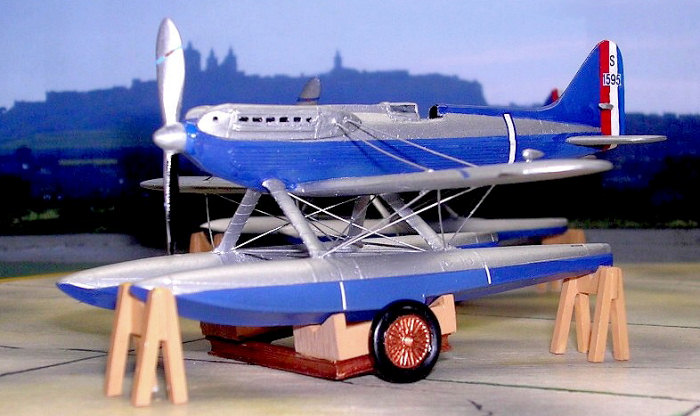
Pavla 1/72 Supermarine S6A/B
| KIT: | Pavla 1/72 Supermarine S6A/B |
| KIT #: | 72060 |
| PRICE: | £16.50 (about $33.00) |
| DECALS: | Several options |
| REVIEWER: | Carmel J. Attard |
| NOTES: | Short run with resin parts and beaching trolley |

| HISTORY |
During a racing aircraft contest held in Venice in 1927 two new all metal S5 monoplanes seaplane, designed by R.J.Mitchell, one powered by a 900hp Napier Lion VIIA and the other with 875hp Napier Lion VIIB took the 1st and 2nd place respectively, and the winner being flown by Flight Lieutenant S.N Webster at an average speed of 281.66mph.
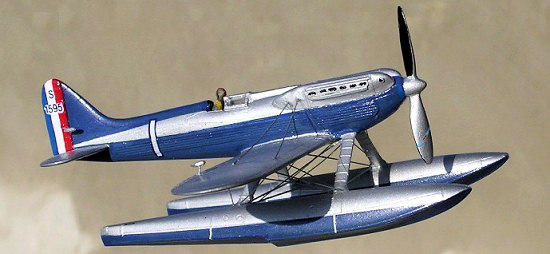 During a penultimate contest in 1929 held
in Calshot, on the south coast of England near Portsmouth the improved S6 having
strengthened floats and rear fuselage and powered by a 1900 hp Rolls Royce ‘R’
engine came first, flown by H.R.Waghorn at a record speed of 328.65 mph. With
lack of government support it then seemed certain that the UK would be unable to
contend in 1931. In the light of this situation a national-spirited sponsorship
by Lady Houston made it possible. With insufficient time to go for a new design
one could do little more than modify the S6 to accept a 2350hp version of the
Rolls Royce ‘R’ engine. The resulting S6B flew over the course at Calshot
uncontested at a record sped of 340.08 mph piloted by Flight Lieutenant J.N.
Boothman to win the Trophy permanently for the UK. This was possible because the
rules of the competition for seaplanes stated that if any country wins the
trophy three consecutive times the country would keep the trophy forever.
During a penultimate contest in 1929 held
in Calshot, on the south coast of England near Portsmouth the improved S6 having
strengthened floats and rear fuselage and powered by a 1900 hp Rolls Royce ‘R’
engine came first, flown by H.R.Waghorn at a record speed of 328.65 mph. With
lack of government support it then seemed certain that the UK would be unable to
contend in 1931. In the light of this situation a national-spirited sponsorship
by Lady Houston made it possible. With insufficient time to go for a new design
one could do little more than modify the S6 to accept a 2350hp version of the
Rolls Royce ‘R’ engine. The resulting S6B flew over the course at Calshot
uncontested at a record sped of 340.08 mph piloted by Flight Lieutenant J.N.
Boothman to win the Trophy permanently for the UK. This was possible because the
rules of the competition for seaplanes stated that if any country wins the
trophy three consecutive times the country would keep the trophy forever.
On the same day, 13th September 1931, flight Lieutenant G H Stainforth used the reserve S6B to establish a new world absolute speed record of 379.05 mph. The combined effort of Supermarine, R.J.Mitchell, Rolls Royce and fuel technician F.Rodwell Bank, had given the UK a remarkable success and later led to develop one of the most famous aircraft of all times, the famous Supermarine Spitfire WWII fighter aircraft.
| THE KIT |
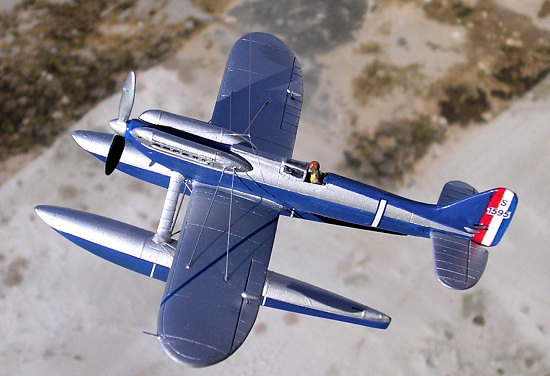 The 8-page A5 size instruction sheet is
very well prepared depicting plan view of the resin parts, a sprue of the
plastic injected parts, vac form cockpit items and placing of decals. There are
eighteen easy to follow step by step stages; the first 12 stages are devoted to
assembly and painting of kit cockpit and the beaching trolley and supporting
frames. The trolley parts are made of resin and seem to be a feature in all
Pavla float plane kits. The resin pieces come in a plastic bag and there is a
pair of vac form transparencies. A good set of decals comes with the kit and
these along with alternative parts cover S6B S1595 that was flown by Flt Lt J.N.
Boothman in winning the Shneider Trophy in September 1931, alternative decals
for S6B S1596 flown by Flt Lt G H Stainforth and S6A N247, converted from the
standard S6 used for practice and as a reserve machine.
The 8-page A5 size instruction sheet is
very well prepared depicting plan view of the resin parts, a sprue of the
plastic injected parts, vac form cockpit items and placing of decals. There are
eighteen easy to follow step by step stages; the first 12 stages are devoted to
assembly and painting of kit cockpit and the beaching trolley and supporting
frames. The trolley parts are made of resin and seem to be a feature in all
Pavla float plane kits. The resin pieces come in a plastic bag and there is a
pair of vac form transparencies. A good set of decals comes with the kit and
these along with alternative parts cover S6B S1595 that was flown by Flt Lt J.N.
Boothman in winning the Shneider Trophy in September 1931, alternative decals
for S6B S1596 flown by Flt Lt G H Stainforth and S6A N247, converted from the
standard S6 used for practice and as a reserve machine.
| CONSTRUCTION |
As the custom is with short run kits, the
fuselage halves contain no guide tabs or sockets to act as guides during
assembly and one can add sprue pieces on the interior to act as suitable guides
to the fuselage. These are added to one side of the fuselage halves. The
interior is painted silver as opposed to interior grey green indicated in the
instructions. I also found that both the oval firewall piece and pilot seat
requires to be ground to reduce in width to allow the f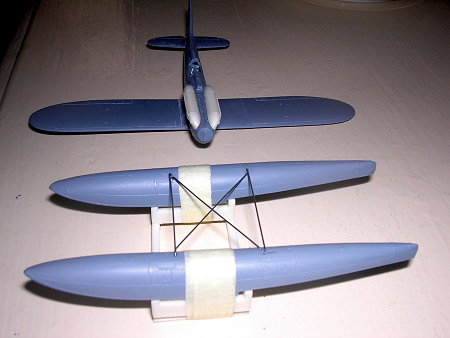 uselage halves to close.
The seat was painted green with linen straps while the instrument panel was
black with white dials. Once the fuselage halves are brought together, then the
fuselage base which is a separate piece, intentionally made so that all the splined surface detail is well injected, is first brought to fit properly. Then
the fuselage halves are placed together and any adjustment is made in situ. Any
minor gap that remains is carefully stopped with putty and subsequent sanding.
uselage halves to close.
The seat was painted green with linen straps while the instrument panel was
black with white dials. Once the fuselage halves are brought together, then the
fuselage base which is a separate piece, intentionally made so that all the splined surface detail is well injected, is first brought to fit properly. Then
the fuselage halves are placed together and any adjustment is made in situ. Any
minor gap that remains is carefully stopped with putty and subsequent sanding.
The engine manifold is in resin and very carefully produced so that it has an edge over previous S6B produced by other manufacturers. There are alternate propeller pieces to choose from. This is left for a final stages but it has a silver front and matt black rear. A make logo decal item is also provided to fit to front of blades. Alternative rudder parts are supplied so that one version will contain a trim tab. Detailed floats are also fitted together. Once these have set, I placed these to rest on the beaching trolley. The float struts were then carefully glued in place so that the fuselage rests on them and checked from front elevation to ensure these are correctly aligned. Having gone through this stage it was turn to add bracing wire. The instruction sheet implies that the bracing wire is made from stretch sprue but I preferred to use thin steel wire cut to correct lengths and glued in place. There were 16 of these having a variety of lengths. The balance weights for control surfaces were finally added. These are fragile and care required in keeping these in one whole piece.
| COLORS & MARKINGS |
I made reference to the box art
for the final paintwork. I first painted the fuselage using Humbrol blue Hu 14.
This was then masked using Tamiya tape and the rest of the kit was painted
silver using local commercial brand thinned 60:40.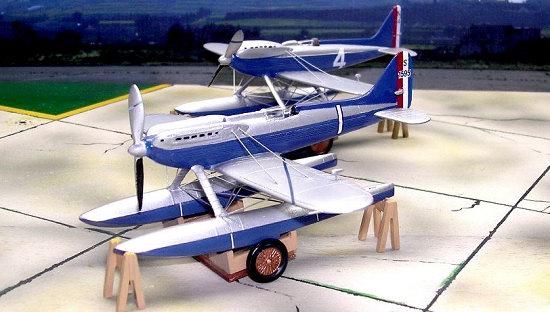
Decals were of good quality and only needed touching up on the rudder area and at its periphery. The rudder serials also contained the thin white outline that one will notice only upon applying them over the red and blue rudder.
| CONCLUSIONS |
This was a delightful kit to build and definitely looked more accurate to an S6B that I built coming from a different brand released long ago. The box art gives indication that this was also the first in a line of kits scheduled to be released in a series consisting of racing aircraft.
| REFERENCES |
-Scale Aircraft Modeller Vol6 No9 May 1984
-The world encyclopaedia of aircraft
February 2008
If you would like your product reviewed fairly and quickly, please contact me or see other details in the Note to Contributors.